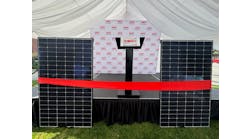With energy storage advancing quickly in the electric power industry, policy finds itself chasing markets. The rules of the road have yet to be sorted out, yet energy storage already is racing ahead.
Energy storage companies are announcing deals, partnerships, financing, innovations and new customers almost daily.
“Since 2013, the market had been vibrant and commercial. It’s not R&D anymore. People aren’t talking about why energy storage is good. They are past that. They are securing energy storage in large quantities,” said Mike Hopkins, CEO of Ice Energy, a thermal energy storage company.
Meanwhile, state policymakers and regulators are still trying to figure out exactly how energy storage plays into the energy mix. Energy storage is not exactly generation or conventional demand-side management, so how should it be treated? Does it need any special incentives or new rates structures? What is its economic worth?
Some states, of course, have moved faster and further than others when it comes to creating policy.
California is the most notable, with its mandate that utilities secure 1.3 GW of energy storage by 2020.
Connecticut, Massachusetts, New York, New Jersey all have created funding or financing programs for energy storage or related microgrids.
New York has set up the Battery and Energy Storage Technology Consortium (NY-Best). Equally significant, it is encouraging storage through its new grid policy, Reforming the Energy Vision (REV).
Michigan has experimented with using renewable energy credits for energy storage. Others like Colorado have undertaken study of the technology.
But many states have yet to take any formal action on energy storage.
So what should states be thinking about as they figure out energy storage policy? It’s not such a new road really. Distributed energy storage will benefit from many of the same policy changes that are good for distributed generation.
Consider the ideas outlined in a recently issued report by the Interstate Renewable Energy Council (IREC), “Deploying Distributed Energy Storage: Near-term Regulatory Considerations to Maximize Benefits.” Many mirror policy discussions underway about distributed generation.
- Create rate structures that send the correct signals, such as time-of-use rates that pay more for energy storage when it will most benefit the grid.
- Let energy storage earn revenue by selling ancillary services to the grid and participating in demand response.
- Set efficient and fair interconnection rules
- Clarify net metering so that energy storage can benefit without jeopardizing renewable energy goals
- Consider distributed energy storage in broader utility planning
- Coordinate government oversight of energy storage
Monetizing Energy Storage
Given that policymakers have dealt with these issues before, it may seem easy. But in truth, energy storage, creates some significant puzzles. One is: How do you monetize it?
Energy storage, of course, helps the building in that it offers back-up supply, so some self-incentive exists for the building owner to invest in the technology. But energy storage also often benefits the larger grid. Energy storage helps smooth the variability of renewables, shores up reliability, reduces strain during peak periods, and provides various ancilliary services.
Shouldn’t the owner be compensated for that? And how?
Businesses and building owners can’t be expected to invest in energy storage for purely altruistic reasons. The benefits that energy storage provide to the grid must be translated into benefits to the owner, said Rick Fioravanti, head of the distributed energy resources section at DNV GL and a board member of NY-BEST.
“It just can’t be a device that does social good. You can’t expect somebody to donate to the social good without getting compensated,” he said in a recent interview.
What might those revenue streams be? Several are being discussed, among them wholesale market payment for ancillary services, demand response and renewable energy credits.
But not all of those streams are on the right side of the market for energy storage owners. For example, a retail customer would have a hard time getting access to revenue for wholesale market services. Market rules aren’t set up to accommodate that kind of transaction. The rules need to be crafted so that broad access exists to the revenue streams, Fioravanti said.
In restructured states, one of the big questions is: Do the competitive rules that apply to generation also apply to energy storage? More specifically, can utilities develop and own energy storage or should that be left to independent third parties?
In New York (a restructured state), the public service commission’s Track 1 REV decision appears to answer that question by creating a carefully defined exception to restructuring rules. Utilities are allowed to own and develop energy storage for reliability purposes.
“That is actually not a minor exception, but a very big exception. That to me is a call to action to monetize or calculate what the social benefit is,” said Fioravanti, who spoke about REV on a panel in March at the NY-BEST annual meeting and conference in Troy, New York.
Under the REV scenario, utilities would likely flow the cost of energy storage into their rates, which must be approved by the public service commission. Hence, utility ownership would necessitate a close look by regulators at the worth of energy storage to society.
The Market Waits for No One
Clearly, policymakers and regulators have many issues to consider when it comes to energy storage, but probably not a lot of time. The entry into the market last month of two major solar players — SunEdison with its purchase of SolarGrid Storage and SolarCity with its microgrid play — made it apparent that energy storage is not going to be a small, quaint niche play.
“It’s a vote of confidence,” said Darren Hammell, co-founder and chief strategy officer for Princeton Power Systems, which supplied the containers and inverters for SolarGrid Storage’s projects. “The cost and the performance of storage are getting better really, really fast. The industry — those that make the batteries and technology — have been trying to get that message across to the utilties and policymakers. But nobody quite understands that as well as the equipment manufacturers. So it has been a tough message for people to comprehend on the policy side.”
Hammell added that if the right policies are put in place to encourage storage they will lead to even faster innovation and market adoption. “It does become a cycle where they feed off each other. But as of today, the policies are very much lagging in North America.”
What policy actions do you believe are needed to foster energy storage? Let us know by commenting below or on Energy Efficiency Markets’ LinkedIn Group.






